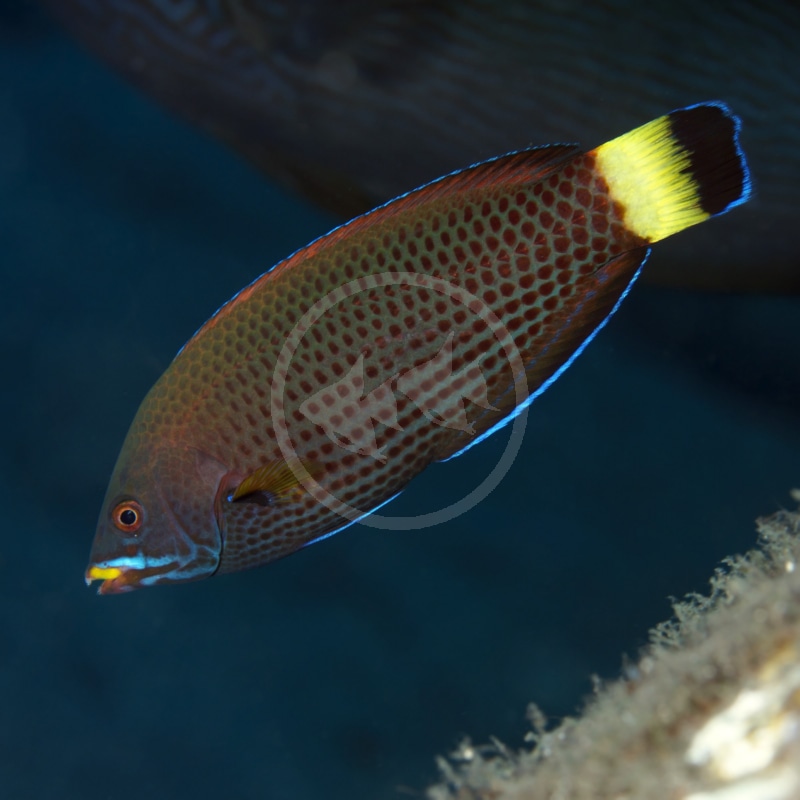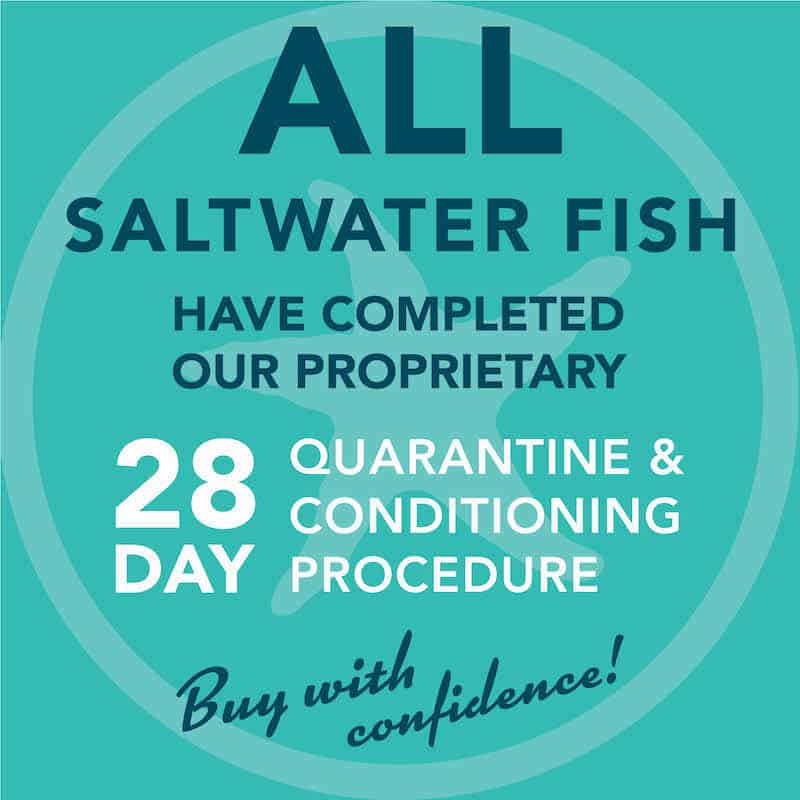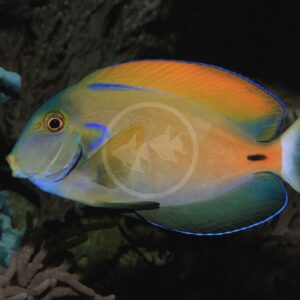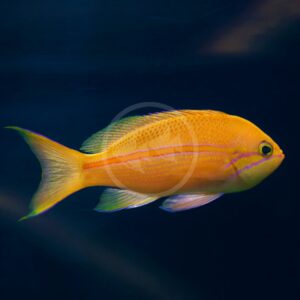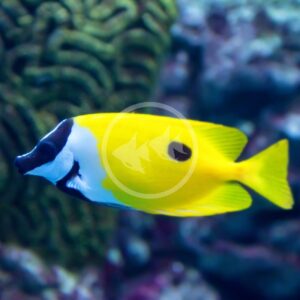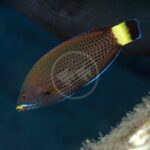

WRASSE – CHISELTOOTH Pseudodax moluccanus
$69.99 – $99.99Price range: $69.99 through $99.99
The Chiseltooth Wrasse has a wide distribution across the Indo-West Pacific, from the Red Sea to the Tuamotu Islands and north toward Japan. The only species in the genus Pseudodax, Chiseltooth wrasses are seldom available in the aquarium trade due to both the difficulty of collecting them and with the low success rate of collected individuals acclimating from importation. When available, juvenile Chiseltooth wrasses are typically offered and resemble the Common Cleaner Wrasse (Labroides dimidiatus) in that they have a blackish body with two lengthwise blue lines. Adults, on the other hand, have red-brown bodies with scales that have a greenish edge and a caudal fin that is bright yellow with a heavy black tip. The lower jaw will also have an iridescent blue stripe. Little is known about the Chiseltooth wrasse in the home aquarium, but its care has been described as similar to that of Anampses wrasses or parrotfish, which require exceptional dedication and attention from the hobbyist in order to thrive long term. Like many other Labrids, the Chiseltooth wrasse requires a moderately-sized to fine sandy substrate in order to be able to bury themselves in. It is very common for your newly introduced wrasse to immediately bury themselves once released into the aquarium. An adult Chiseltooth wrasse can reach a size of approximately 8″. Note: We have found through our 28 day quarantine process that allowing Chiseltooth wrasses time to recover and adjust from importation is extremely important. Here, we are then able to also focus on providing the appropriate nutrition of these wrasses, setting up our individual Chiseltooth wrasses for better success.
Care Level: Advanced
Temperament: Peaceful
Reef Compatible: With Caution
General Description: The Chiseltooth Wrasse has a wide distribution across the Indo-West Pacific, from the Red Sea to the Tuamotu Islands and north toward Japan. The only species in the genus Pseudodax, Chiseltooth wrasses are seldomly available in the aquarium trade due to both the difficulty of collecting them and with the low success rate of collected individuals acclimating from importation. When available, juvenile Chiseltooth wrasses are typically offered and resemble the Common Cleaner Wrasse (Labroides dimidiatus) in that they have a blackish body with two lengthwise blue lines. Adults, on the other hand, have red-brown bodies with scales that have a greenish edge and a caudal fin that is bright yellow with a heavy black tip. The lower jaw will also have an iridescent blue stripe. Little is known about the Chiseltooth wrasse in the home aquarium, but its care has been described as similar to that of Anampses wrasses or parrotfish, which require exceptional dedication and attention from the hobbyist in order to thrive long term. Like many other Labrids, the Chiseltooth wrasse requires a moderately-sized to fine sandy substrate in order to be able to bury themselves in. It is very common for your newly introduced wrasse to immediately bury themselves once released into the aquarium. An adult Chiseltooth wrasse can reach a size of approximately 8″. Note: We have found through our 28 day quarantine process that allowing Chiseltooth wrasses time to recover and adjust from importation is extremely important. Here, we are then able to also focus on providing the appropriate nutrition of these wrasses, setting up our individual Chiseltooth wrasses for better success.
Diet Requirements: Chiseltooth wrasses are carnivores, actively hunting small snails, worms and shrimp. A diet consisting of various meaty preparations such as brine shrimp, mysis shrimp, and other mixed frozen foods that also contain algae, such as spirulina, will maintain optimal health and coloration. We highly encourage soaking frozen foods in vitamin and fatty acid supplements, as these wrasses have very high metabolisms. Multiple, small feedings per day rather than one large feeding can also help and in turn create more of a natural environment for a Chiseltooth wrasse as it would feed in the wild.
Care Requirements: An minimum 75 gallon aquarium with a 3″ sandbed at the very least is needed for a juvenile Chiseltooth wrasse. The aquarium may need to be upgraded accordingly as this species grows. The Chiseltooth wrasse should not be introduced into a biologically immature aquarium because it is absolutely intolerable of nitrite or ammonia spikes. A mature aquarium also offers the abundant microinvertebrate and crustacean fauna (such as amphiopods) that a Chiseltooth wrasse can forage on. Chiseltooth wrasses enjoy a variety of rock work and crevices to swim through and around while they hunt. Such live rock arrangements can also help to make it feel secure and encourage more outgoing behavior. Given their peaceful nature as juveniles, a Chiseltooth wrasse should not be kept with aggressive species. As it matures, the Chiseltooth wrasse could become a bully toward timid tank mates. While the Chiseltooth wrasse will ignore corals, we have this fish listed to add “With Caution” into a reef setting because ornamental shrimps, crabs and snails are all at risk of being predated on – especially by an adult Chiseltooth wrasse. Recommended water conditions, 72-78° F, KH 8-12, pH 8.1-8.4, salinity 1.020-1.025.
Purchase Size: Small Juvenile: 1-1/2″ to 2-1/4″; Medium: 2-1/2″ to 3-1/2″; Large: 3-3/4″ to 4-3/4″
Note: Your item may not look identical to the image provided due to variation within species. Purchase sizes are approximate.
Dry goods orders are shipped via US Postal Service or UPS to the address provided at checkout based on the selection made in your website shopping cart. Product is carefully packed to help prevent any damage during shipping. Once processed you will receive a shipment notification via email with tracking number, and delivery notification. Please allow 48 hours for processing after your order is placed.
Perishable items (i.e. live plants, refrigerated/frozen foods) are shipped via US Postal Service 2-3 day to the address provided at checkout for a $25.00 flat rate charge. Items are packed with secure packing material and heat, cold, or Cryo packs as needed to maintain safe temperatures during transit. If one or more perishable items are in the shopping cart at checkout the $25.00 perishable shipping charge will automatically appear and need to be selected. Once processed you will receive a shipment notification via email with tracking number. Please allow 48 hours for processing after your order is placed.
Livestock (i.e. fish, invertebrates, coral) are shipped via UPS Overnight to the address provided at checkout for a $55.00 flat rate charge. Livestock is packed in insulated styrofoam boxes with secure packing material and heat, cold, or Cryo packs as needed to maintain safe temperatures during transit. If one or more livestock items are in the shopping cart at checkout the $55.00 livestock shipping charge will automatically appear and need to be selected. Livestock is shipped Monday through Wednesday ONLY (no weekend delivery is available) weather permitting, and we reserve the right to delay shipping until conditions are appropriate for safe arrival. Once your order is placed we will contact you to arrange the best shipping date based on these criteria. Someone must be available to receive the livestock order on the first delivery attempt. Once processed you will receive a shipment notification via email with tracking number. Please allow 48 hours for processing after your order is placed.
For mixed dry goods/perishable & livestock orders items will be shipped via their corresponding shipping methods outlined above. Dry goods will be shipped via US Postal Service or UPS based on your selection and checkout, while livestock will ship via UPS Overnight for a $55.00 flat rate charge. You will receive separate notifications and tracking numbers for the dry goods and livestock. Please note due to different carriers and shipping methods dry goods and livestock may arrive on different days.
Related products

MINNOW – WHITE CLOUD MOUNTAIN GOLD
Tanichthys albonubes
$5.99


TANG – YELLOW Zebrasoma flavescens
$174.99 – $399.99Price range: $174.99 through $399.99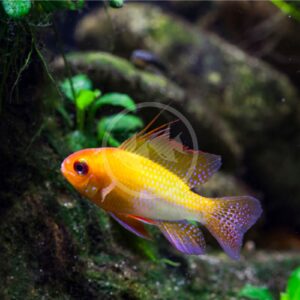
CICHLID – RAM GERMAN GOLD
Mikrogeophagus ramirezi
$5.99 – $16.99Price range: $5.99 through $16.99
RABBITFISH – ONE SPOT FOXFACE Siganus unimaculatus
$119.99 – $199.99Price range: $119.99 through $199.99ANGEL DWARF – PYGMY ATLANTIC / CHERUB Centropyge argi
$69.99 – $99.99Price range: $69.99 through $99.99

WRASSE – LEOPARD VERMICULATE Macropharyngodon bipartitus
$129.99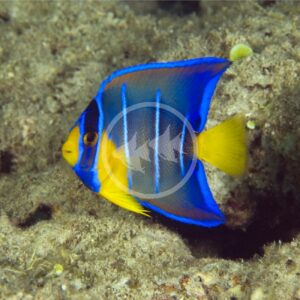

ANGEL – BLUE Holacanthus bermudensis
$319.99

